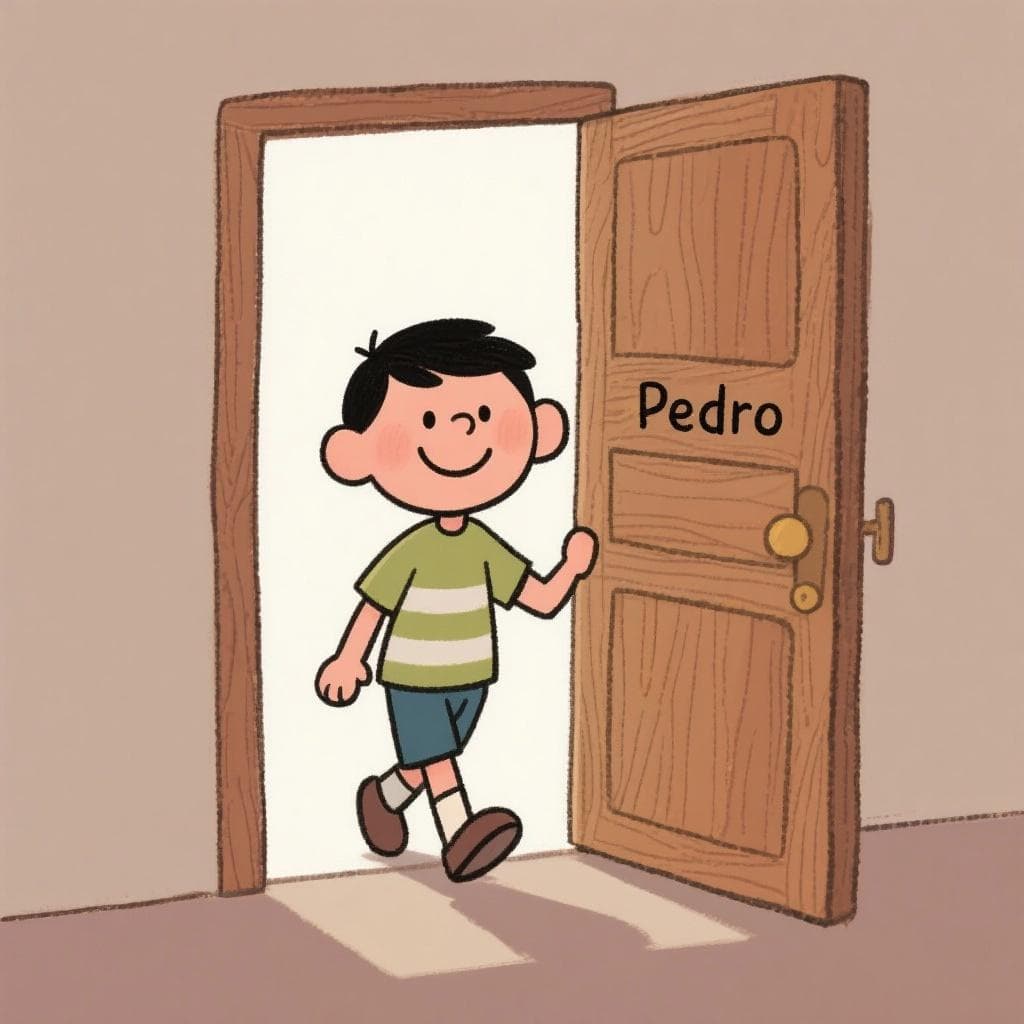Por la puerta va Pedro.
por la PUER-ta va PE-dro
Pedro goes through the door.
🔊 Listen & Practice
Start with slow speed to master pronunciation, then gradually increase to challenge yourself.
🎨 Visualization

Por la puerta va Pedro. A perfect short phrase to master two key Spanish sounds!
🎯 Pronunciation Focus
The Unaspirated 'p'
/p/The Spanish 'p' is crisp and clean, made without the puff of air we use in English (like in 'Paul'). To practice, hold your hand in front of your mouth. When you say 'Por' or 'Pedro' correctly, you should feel almost no breath.
The Soft 'r' (vibrante simple)
/ɾ/This is a quick, single tap of the tip of your tongue against the roof of your mouth, just behind your teeth. It’s the same sound many American English speakers use for the 'tt' in 'butter' or 'dd' in 'ladder'.
📝 Practice Breakdown
Start here. Focus on making a clean 'p' sound, with no puff of air. Then, for 'puerta', let your tongue do a quick tap for the 'r' sound.
End with the name. Again, a crisp 'p'. The 'dr' combination can be tricky. Think of it as one smooth motion: 'd' followed immediately by the quick 'r' tap.
Key Words in This Tongue Twister:
📚 Background
This isn't a complex story, but rather a classic pronunciation drill in the Spanish-speaking world. It's often one of the first 'trabalenguas' that children and new learners use to practice the clean 'p' sound and the tapped 'r', which are fundamental to sounding natural in Spanish.
❌ Common Pitfalls
Using an Airy, English 'p'
Mistake: "Pronouncing 'Por', 'puerta', and 'Pedro' with a strong puff of air, like the English words 'pour', 'puppy', or 'Peter'."
Correction: Press your lips together and release the 'p' sound without any extra breath. It should sound sharp and quick. Try saying it with your palm in front of your lips – you shouldn't feel a gust of wind.
Using a Heavy, English 'r'
Mistake: "Making the 'r' sound in the back of your throat, like the English 'r' in 'door' or 'car'."
Correction: The Spanish 'r' in these words is made at the front of your mouth. It's a very light, quick tap of your tongue on the ridge behind your top teeth. It's over in an instant!
🌎 Where It's Used
General Spanish
This simple phrase is a universal tool for pronunciation practice across all Spanish-speaking countries. Its sounds are consistent everywhere.
🔗 Related Tongue Twisters
The Pedro Door Dash
Say 'Por la puerta va Pedro' five times in a row. Try to keep the rhythm steady and the 'p' and 'r' sounds consistent each time. Can you do it in under 7 seconds?
🏷️ Tags
Frequently Asked Questions
Is the 'd' in 'Pedro' a hard 'd' like in English?
Great question! It's a bit softer. In Spanish, when a 'd' comes after a consonant like 'r' (as in 'Pedro'), it's pronounced clearly. However, a 'd' between two vowels (like in 'lado') is much softer, almost like the 'th' sound in the English word 'the'.
Why is the 'p' sound so different in Spanish?
It's just one of the fun differences between languages! Spanish 'p', 't', and 'k' sounds are 'unaspirated,' meaning they don't have that extra puff of air that English speakers naturally add. Mastering this will instantly make your Spanish sound more authentic.


